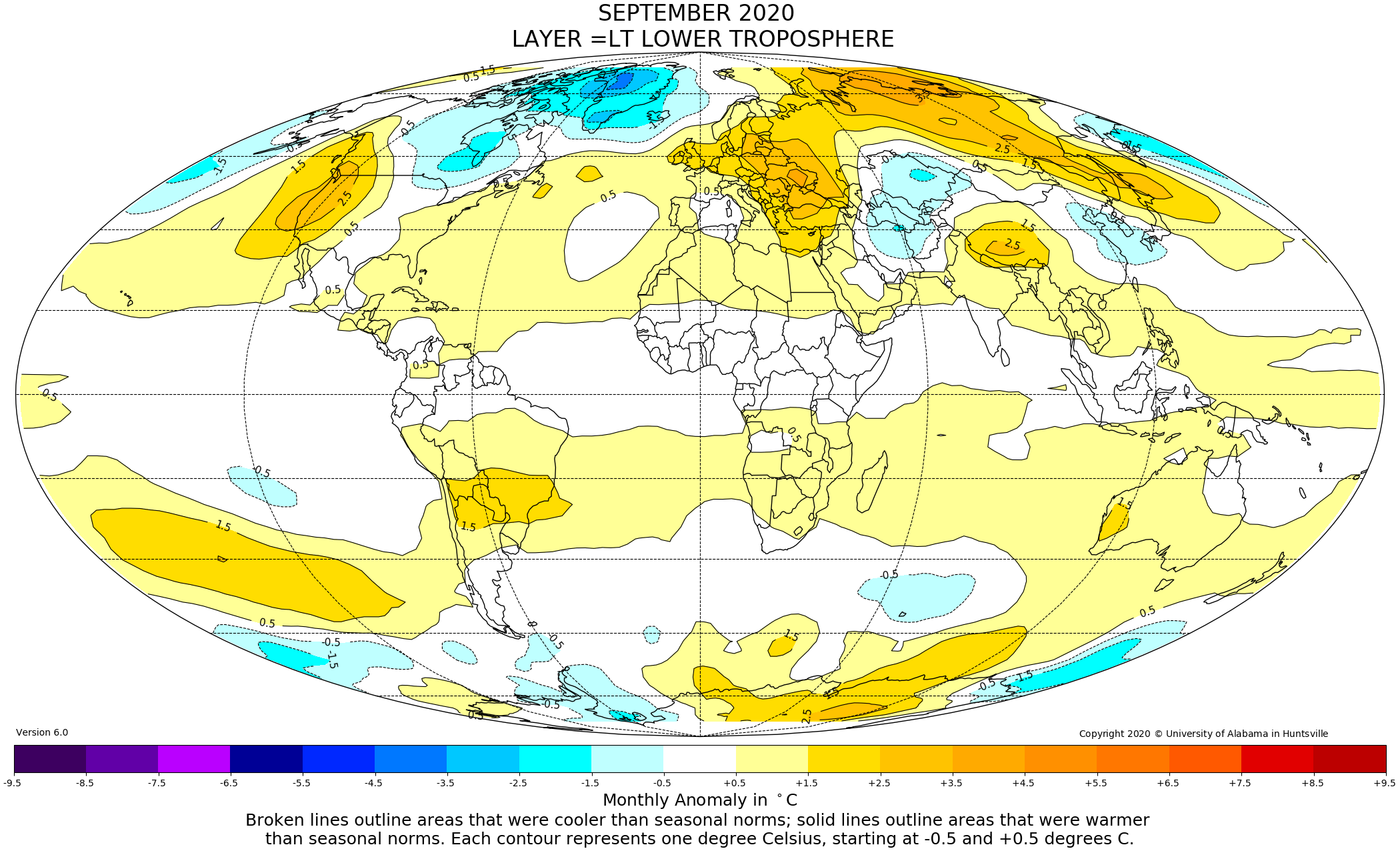Global Temperature Report: September 2020
Global climate trend since Dec. 1 1978: +0.14 °C (+0.25 °F) per decade
September Temperatures (preliminary)
Global composite temp.: +0.57 °C (+1.03 °F) above seasonal average
Northern Hemisphere: +0.58 °C (+1.04 °F) above seasonal average
Southern Hemisphere: +0.56 °C (+1.01 °F) above seasonal average
Tropics: +0.46 °C (+0.83 °F) above seasonal average
August Temperatures (final)
Global composite temp.: +0.43 °C (+0.77 °F) above seasonal average
Northern Hemisphere: +0.47 °C (+0.85 °F) above seasonal average
Southern Hemisphere: +0.38 °C (+0.68 °F) above seasonal average
Tropics: +0.59 °C (+1.06 °F) above seasonal average
Notes on data released October 2, 2020 (v6.0)
September’s seasonally-adjusted, large-scale temperature averages were both unexpected and expected. The pattern that held over the past two months, with the tropics relatively warmer than mid-latitude zones, flipped in September with zones outside of the tropics warming up and the tropics cooling off a bit. The latter change was entirely expected as the La Niña cooling of the tropical Pacific is now well-established and NOAA has issued a La Niña Advisory. See the latest here:
https://www.cpc.ncep.noaa.gov/products/analysis_monitoring/lanina/enso_evolution-status-fcsts-web.pdf
The different warming response at higher latitudes, especially over land, overpowered the tropical cooling so that the global temperature departure rose to +0.57 °C (+1.03 °F) from +0.43 °C (+0.77 °F) in August. In fact, the global land anomaly of +0.75 °C (1.35 °F) was the warmest such value in the 42 Septembers on record (other non-September months have seen higher values.)
As we’ve seen in the past, it is often the case that the globe’s warmest and coolest temperature departures are near each other, representing the peak and trough of an atmospheric wave pattern that was fairly stationary. The warmest spot (i.e. warmest departure from normal) occurred over Northern Russia along the Khatanga River at +4.3 °C (+7.8 °F). Other very warm areas are found along the U.S. west coast, over eastern Europe to Ukraine, South Pacific Ocean to central South America, and finally eastern Antarctica.
Colder than average regions were less extensive, with the coldest spot over northeastern Greenland at -3.9 °C (-6.9 °F), being only 3,000 km from the warmest spot. This cold region covered all of Greenland and extended SW to the Hudson Bay. It was cooler than average over Kazakhstan, the north Pacific Ocean and parts of the far south Pacific Ocean too.
Overall, the conterminous U.S. experienced an above-average temperature of +0.97 °C (+2.00 °F) with the western third quite a bit above average. Alaska was not as warm so that the 49-state mean temperature departure was a bit lower than the 48-state value at +0.86 °C (+1.55 °F). [We don’t include Hawaii in the US results because its land area is less than that of a satellite grid square, so it would have virtually no impact on the overall national results.]
Spoiler Alert first published March 2019: As noted over the past several months in this report, the drifting of satellites NOAA-18 and NOAA-19, whose temperature errors were somewhat compensating each other, will be addressed in this updated version of data released from March 2019 onward. As we normally do in these situations we have decided to terminate ingestion of NOAA-18 observations as of 1 Jan 2017 because the corrections for its significant drift were no longer applicable. We have also applied the drift corrections for NOAA-19 now that it has started to drift far enough from its previous rather stable orbit. These actions will eliminate extra warming from NOAA-18 and extra cooling from NOAA-19. The net effect is to introduce slight changes from 2009 forward (when NOAA-19 began) with the largest impact on annual, global anomalies in 2017 of 0.02 °C. The 2018 global anomaly changed by only 0.003°C, from +0.228°C to +0.225°C. These changes reduce the global trend by -0.0007 °C/decade (i.e. 7 ten-thousandths of a degree) and therefore does not affect the conclusions one might draw from the dataset. The v6.0 methodology is unchanged as we normally stop ingesting satellites as they age and apply the v6.0 diurnal corrections as they drift.
To-Do List: There has been a delay in our ability to utilize and merge the new generation of microwave sensors (ATMS) on the NPP and JPSS satellites. As of now, the calibration equations applied by the agency have changed at least twice, so that the data stream contains inhomogeneities which obviously impact the type of measurements we seek. We are hoping this is resolved soon with a dataset that is built with a single, consistent set of calibration equations. In addition, the current non-drifting satellite operated by the Europeans, MetOP-B, has not yet been adjusted or “neutralized” for its seasonal peculiarities related to its unique equatorial crossing time (0930). While these MetOP-B peculiarities do not affect the long-term global trend, they do introduce error within a particular year in specific locations over land.
As part of an ongoing joint project between UAH, NOAA and NASA, Christy and Dr. Roy Spencer, an ESSC principal scientist, use data gathered by advanced microwave sounding units on NOAA, NASA and European satellites to produce temperature readings for almost all regions of the Earth. This includes remote desert, ocean and rain forest areas where reliable climate data are not otherwise available. Research Associate Rob Junod assists in the preparation of these reports.
The satellite-based instruments measure the temperature of the atmosphere from the surface up to an altitude of about eight kilometers above sea level. Once the monthly temperature data are collected and processed, they are placed in a “public” computer file for immediate access by atmospheric scientists in the U.S. and abroad.
The complete version 6 lower troposphere dataset is available here:
http://www.nsstc.uah.edu/data/msu/v6.0/tlt/uahncdc_lt_6.0.txt
Archived color maps of local temperature anomalies are available on-line at:
http://nsstc.uah.edu/climate/
Neither Christy nor Spencer receives any research support or funding from oil, coal or industrial companies or organizations, or from any private or special interest groups. All of their climate research funding comes from federal and state grants or contracts.
